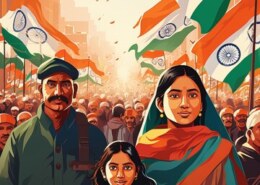Sorry it's a private question.
Introduction: India's complex religious landscape and historical background make religion and politics there closely intertwined. The interaction between these two domains has a major impact on the country's political structure. Historical Context: India has a millennium-long tradition of religiousRead more
Introduction:
India’s complex religious landscape and historical background make religion and politics there closely intertwined. The interaction between these two domains has a major impact on the country’s political structure.
Historical Context:
India has a millennium-long tradition of religious plurality, embracing Buddhism, Sikhism, Jainism, Islam, Christianity, and other faiths. Throughout the colonial era, the British government implemented a policy known as “divide and rule,” which deepened religious tensions and planted the seeds of communalism. The Indian Constitution created a secular framework after independence that guaranteed freedom of religion and maintained the state’s impartiality on religious issues.
Secularism and Its Challenges:
Being unique, Indian secularism aims to strike a compromise between state neutrality and religion plurality. Indian secularism recognises the religious identities of its citizens, as contrast with Western secularism, which promotes a rigid separation of church and state. This inclusive strategy seeks to treat all religions with equal respect.
But problems still exist. Political parties frequently use religious feelings to win over voters, which polarises society. Discussions on the nature of Indian secularism and how it should be implemented have been triggered by the advent of majoritarian politics, particularly with the spread of Hindutva ideology.
Communalism and Social Cohesion:
India’s social cohesiveness is seriously threatened by communalism, which has a propensity to erect religious divisions. Interfaith harmony is vulnerable to violent incidents like the anti-Sikh riots in 1984, the Gujarat riots in 2002, and more recent conflicts. These kinds of gatherings frequently have political undertones, with opposing factions using religious identities as a political tool.
Legal and Constitutional Safeguards:
The Indian Constitution offers a number of protections to maintain secularism. While Articles 14 and 15 establish equality before the law and forbid discrimination based on religion, Articles 25–28 guarantee religious freedom. The use of religion in political campaigns is outlawed by the Representation of the People Act of 1951. Nonetheless, there is still uneven application of these regulations.
Conclusion:
In India, the relationship between politics and religion is a complicated and dynamic phenomena. Political exploitation of religious identities persists in undermining the secular framework’s goal of preserving religious diversity and fostering peace. Sustaining India’s pluralistic democracy requires bolstering secular ideals, encouraging interreligious dialogue, and guaranteeing impartial law enforcement.
See less


Banking regulations in India aim to make banking accessible to everyone, especially those in underserved areas. The Reserve Bank of India (RBI) has introduced various measures to promote financial inclusion. One key initiative is the Pradhan Mantri Jan Dhan Yojana, which encourages opening no-frillsRead more
Banking regulations in India aim to make banking accessible to everyone, especially those in underserved areas. The Reserve Bank of India (RBI) has introduced various measures to promote financial inclusion. One key initiative is the Pradhan Mantri Jan Dhan Yojana, which encourages opening no-frills bank accounts with minimal requirements. This helps low-income individuals access banking services without high fees or complex documentation.
See lessThe RBI also mandates that banks set up branches in rural and semi-urban areas to ensure that even remote populations have access to banking facilities. Additionally, the introduction of business correspondents (BCs) allows banks to reach out to people in far-flung areas through local representatives. Mobile banking and digital payment systems have further eased access, enabling people to manage finances through their phones. These efforts collectively help bring more people into the formal banking system, promoting economic growth and reducing inequality.